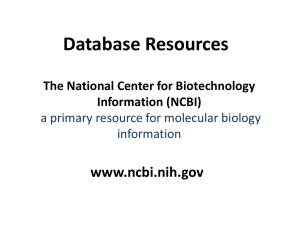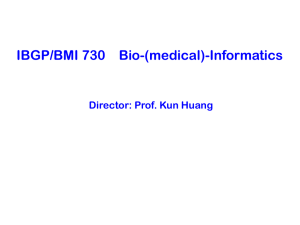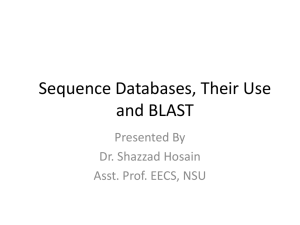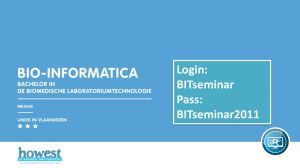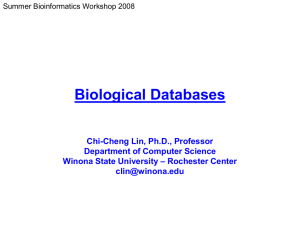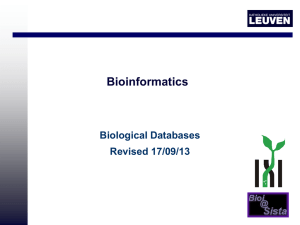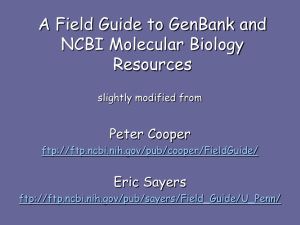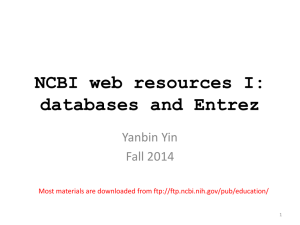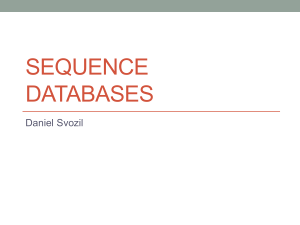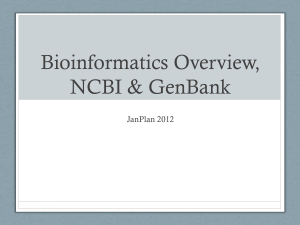NCBI Databases & Entrez: Intro to Biological Databases
advertisement
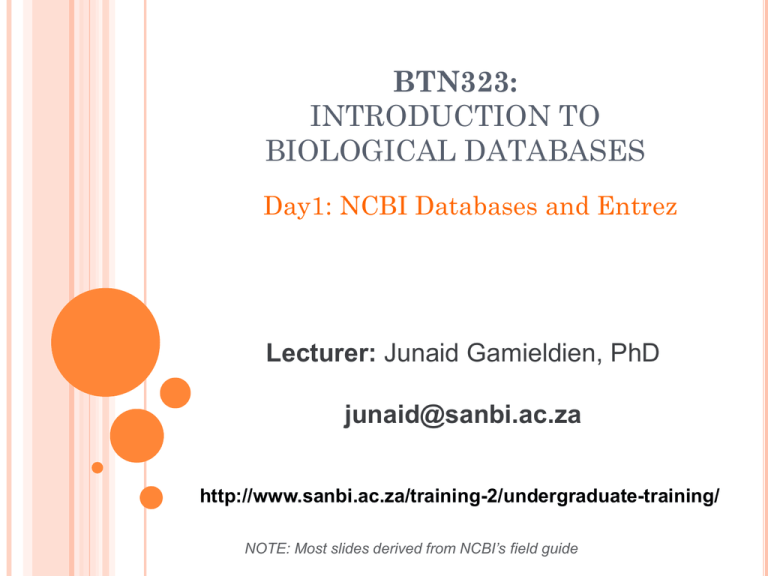
BTN323: INTRODUCTION TO BIOLOGICAL DATABASES Day1: NCBI Databases and Entrez Lecturer: Junaid Gamieldien, PhD junaid@sanbi.ac.za http://www.sanbi.ac.za/training-2/undergraduate-training/ NOTE: Most slides derived from NCBI’s field guide WHAT YOU NEED TO LEARN: What is a database and what are the features of an ideal db? What are the relationships/differences between primary and derived sequence databases? What are the benefits of RefSeq? Why is data integration useful? THE NATIONAL CENTER FOR BIOTECHNOLOGY INFORMATION Bethesda,MD Created in 1988 as a part of the National Library of Medicine at NIH – – – – Establish public databases Research in computational biology Develop software tools for sequence analysis Disseminate biomedical information WEB ACCESS: WWW.NCBI.NLM.NIH.GOV New pages! New Homepage Common footer WHAT ARE DATABASES? Structured collection of information. Consists of basic units called records or entries. Each record consists of fields, which hold predefined data related to the record. For example, a protein database would have protein entries as records and protein properties as fields (e.g., name of protein, length, amino-acid sequence) THE ‘PERFECT’ DATABASE Comprehensive, but easy to search. Annotated, but not “too annotated”. A simple, easy to understand structure. Cross-referenced. Minimum redundancy. Easy retrieval of data. THE CENTRAL DOGMA & BIOLOGICAL DATA Original DNA Sequences (Genomes) Expressed DNA sequence ( = mRNA Sequences = cDNA sequences) Expressed Sequence Tag (ESTs) Protein Sequences -Inferred -Direct sequencing Protein structures -Experiments -Models (homologues) Literature information NCBI DATABASES AND SERVICES GenBank primary sequence database Free public access to biomedical literature PubMed free Medline (3 million searches per day) PubMed Central full text online access Entrez integrated molecular and literature databases TYPES OF MOLECULAR DATABASES Primary Databases Original submissions by experimentalists Content controlled by the submitter Examples: GenBank, Trace, SRA, SNP, GEO Derivative Databases Derived from primary data Content controlled by third party (NCBI) Examples: NCBI Protein, Refseq, TPA, RefSNP, GEO datasets, UniGene, Homologene, Structure, Conserved Domain PRIMARY VS. DERIVATIVE SEQUENCE DATABASES RefSeq Labs Sequencing Centers TATAGCCG AGCTCCGATA CCGATGACAA Curators TATAGCCG TATAGCCG TATAGCCG TATAGCCG Genome Assembly Updated continually by NCBI GenBank UniGene Updated ONLY by submitters Algorithms SEQUENCE DATABASES AT NCBI Primary GenBank: NCBI’s primary sequence database Trace Archive: reads from capillary sequencers Sequence Read Archive: next generation data Derivative GenPept (GenBank translations) Outside Protein (UniProt—Swiss-Prot, PDB) NCBI Reference Sequences (RefSeq) GENBANK - PRIMARY SEQUENCE DB Nucleotide only sequence database Archival in nature Historical Reflective of submitter point of view (subjective) Redundant Data Direct submissions (traditional records) Batch submissions FTP accounts (genome data) GENBANK - PRIMARY SEQUENCE DB (2) Three collaborating databases 1. GenBank 2. DNA Database of Japan (DDBJ) 3. European Molecular Biology Laboratory (EMBL) Database TRADITIONAL GENBANK RECORD ACCESSION U07418 VERSION U07418.1 Version Tracks changes in sequence well annotated the sequence is the data Accession •Stable •Reportable •Universal GI:466461 GI number NCBI internal use DERIVATIVE SEQUENCE DATABASES GENPEPT: GENBANK CDS TRANSLATIONS FEATURES source gene CDS Location/Qualifiers 1..2484 /organism="Homo sapiens" /mol_type="mRNA" /db_xref="taxon:9606" /chromosome="3" /map="3p22-p23" 1..2484 >gi|463989|gb|AAC50285.1| DNA mismatch repair prote... /gene="MLH1" 22..2292 MSFVAGVIRRLDETVVNRIAAGEVIQRPANAIKEMIENCLDAKSTSIQVIV... EDLDIVCERFTTSKLQSFEDLASISTYGFRGEALASISHVAHVTITTKTAD... /gene="MLH1" /note="homolog of S. cerevisiae PMS1 (Swiss-Prot Accession Number P14242), S. cerevisiae MLH1 (GenBank Accession Number U07187), E. coli MUTL (Swiss-Prot Accession Number P23367), Salmonella typhimurium MUTL (Swiss-Prot Accession Number P14161) and Streptococcus pneumoniae (Swiss-Prot Accession Number P14160)" /codon_start=1 /product="DNA mismatch repair protein homolog" /protein_id="AAC50285.1" /db_xref="GI:463989" /translation="MSFVAGVIRRLDETVVNRIAAGEVIQRPANAIKEMIENCLDAKS TSIQVIVKEGGLKLIQIQDNGTGIRKEDLDIVCERFTTSKLQSFEDLASISTYGFRGE ALASISHVAHVTITTKTADGKCAYRASYSDGKLKAPPKPCAGNQGTQITVEDLFYNIA TRRKALKNPSEEYGKILEVVGRYSVHNAGISFSVKKQGETVADVRTLPNASTVDNIRS REFSEQ: DERIVATIVE SEQUENCE DATABASE Curated transcripts and proteins Model transcripts and proteins Assembled Genomic Regions Chromosome records Human genome microbial organelle ftp://ftp.ncbi.nih.gov/refseq/release/ SELECTED REFSEQ ACCESSION NUMBERS mRNAs and Proteins NM_123456 NP_123456 NR_123456 XM_123456 XP_123456 XR_123456 Gene Records NG_123456 Chromosome NC_123455 AC_123455 Assemblies NT_123456 NW_123456 Curated mRNA Curated Protein Curated non-coding RNA Predicted mRNA Predicted Protein Predicted non-coding RNA Reference Genomic Sequence Microbial replicons, organelle Alternate assemblies Contig WGS Supercontig GENBANK TO REFSEQ REFSEQS: ANNOTATION REAGENTS Genomic DNA (NC, NT, NW) Scanning.... Model mRNA (XM) (XR) Curated mRNA (NM) (NR) RefSeq GenBank Sequences Model protein (XP) =? Curated Protein (NP) REFSEQ BENEFITS Non-redundancy Updates to reflect current sequence data and biology Data validation Format consistency Distinct accession series Stewardship by NCBI staff and collaborators OTHER DERIVATIVE DATABASES Expressed Sequences dbSNP Structure Gene and more… ENTREZ FINDING RELEVANT INFORMATION IN NCBI DATABASES ENTREZ: A DISCOVERY SYSTEM Word weight PubMed abstracts Pre-computed and pre-compiled data. 3 -D 3-D Taxonomy Phylogeny BLAST Structure Structure •A potential “gold mine” of undiscovered relationships. Gene •Used less than expected. Protein sequences Nucleotide sequences Neighbors Related Sequences Hard Link VAST Neighbors Related Structures BLAST Neighbors Related Sequences BLink Domains GLOBAL QUERY: ALL NCBI DATABASES The Entrez system: 38 (and counting) integrated databases TRADITIONAL METHOD: THE LINKS MENU DNA Sequence Nucleotide – Protein Link Related Proteins Protein – Structure Link 3-D Structure THE PROBLEM Rapidly growing databases with complex and changing relationships Rapidly changing interfaces to match the above Result Many people don’t know: Where to begin Where to click on a Web page Why it might be useful to click there GLOBAL NCBI (ENTREZ) SEARCH colon cancer GLOBAL ENTREZ SEARCH RESULTS ENTREZ TIP: START SEARCHES IN GENE Entrez Protein Other Entrez DBs BLink Gene Homologene: Gene Neighbors HomoloGene UniGene PRECISE RESULTS MLH1[Gene Name] AND Human[Organism] MLH1 GENE RECORD MLH1:LINKS TO SEQUENCE GENEVIEW: HUMAN MLH1 VARIATIONS ATPase domain ‘TAKE HOME MESSAGE’ ADVANTAGES OF DATA INTEGRATION More relevant inter-related information in one place Makes it easier to find additional relevant information related to your initial query Potentially find information indirectly linked, but relevant to your subject of interest uncover non-obvious genetic features that explain phenotype or disease Easier to build a ‘story’ based on multiple pieces of biological evidence

